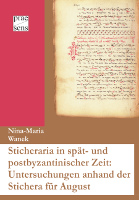Sa contribution pour la conférence à Genève 2011 est publiée maintenant:
Alexandru, Maria. 2013. “Byzantine kalophonia, illustrated by St. John Koukouzeles’ piece Φρούρηζον πανένδοξε in honour of St. Demetrios from Thessaloniki. Issues of notation and analysis.” Studii Şi Cercetări de Istoria Artei. Teatru, Muzică, Cinematografie 49-50. Serie Novă 5-6: 57–105.
Abstract
The present paper explores some aspects of the so-called kalophonic musical style which flourished during the last centuries of Byzantium. It focuses on a masterpiece by St. John Koukouzeles, namely the epibole Φρούρησον πανένδοξε (Ο Allglorious, keep watch over the city), in honor of St. Demetrios, the protector of Thessaloniki, and is complementary to some previous musicological analysis of this piece by Stephania Meralidou. After a brief presentation of the old sticheron Ἔχει μὲν ἡ θειοτάτη σου ψυχή, whereof St. John takes his departing point for the kalophonic composition, the paper concentrates on a multi-level analysis of the epibole, firstly on the ground of the late middle-Byzantine notation, according to the ms Vlatadon 46 (A.D. 1551), and secondly by comparing the old notation to its slow exegesis in new-Byzantine notation by Chourmouzios Chartophylax (score and recording issued by the Greek Byzantine Choir, dir. L. Angelopoulos).
The analysis comprises several approaches like textual, music-architectural, modal, micro-syntactical, rhetorical, macro-syntactical, generative, comparative (cf. plates 7-12, 17-20. Since this material is also suitable for didactic purposes, the different plates are given again in the appendix, in form of exercises to be filled in by interested students).
The different analytical approaches reveal the highly refined melodic fabric of kalophonia with its plethora of theseis-combinations, the extensive use of music-rhetorical devices, basic norms of the complex art of musical exegesis in this style, as well as the beauty of this kind of melodies, which have been acknowledged to represent the ‘zenith’ of Byzantine music (Wellesz).
Keywords: Kalophonia, Musicological analysis of Byzantine chant, Hesychasm, St. Demetrios of Thessaloniki, Exegesis, Sectio aurea
Interpretation by the Greek-Byzantine Choir
Μέλος Αγίου Ιωάννου Κουκουζέλους. Ψάλλει η ΕΛ.ΒΥ.Χ. υπό την διεύθυνση του Λυκούργου Αγγελόπουλου
"Φρούρησον πανένδοξε την σε μεγαλύνουσαν πόλιν από των εναντίον προσβολών,
παρρησίαν ως έχων,
προς Χριστόν τον σε δοξάσαντα.
Αοίδιμε Δημήτριε,
φρούρησον την σε τιμώσαν πόλιν,
τους άνακτας συμμάχησον,
την πόλιν σου στερέωσον,
τους σε τιμώντας ευσεβώς αοίδιμε Δημήτριε
(κράτημα τε -ρι - ρεμ)
παρρησίαν ως έχων προς Χριστόν τον σε δοξάσαντα."

